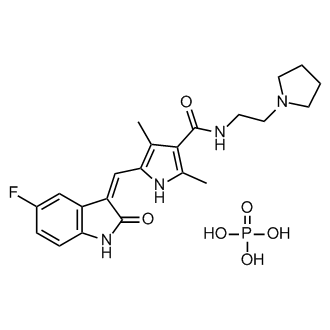Toceranib (phosphate)
CAS No. : 874819-74-6
(Synonyms: SU11654 (phosphate); PHA 291639E (phosphate))

| Size | Price | Stock |
|---|---|---|
| 5mg | $32 | In-stock |
| 10mg | $50 | In-stock |
| 25mg | $85 | In-stock |
| 50mg | $100 | In-stock |
| 100mg | $150 | In-stock |
| 200 mg | Get quote | |
| 500 mg | Get quote | |
| We match the lowest price on market. | ||
We offer a substantial discount on larger orders, please inquire via [email protected]
or Fax: (86)21-58955996
Inquiry for price and availability only. Please place your order via our email or fax.
| Cat. No. : | HY-10330A |
| M.Wt: | 494.45 |
| Formula: | C22H28FN4O6P |
| Purity: | >98 % |
| Solubility: | DMSO : 2.46 mg/mL (4.98 mM; Need ultrasonic and warming); H2O : < 0.1 mg/mL (insoluble) |
Toceranib phosphate (SU11654 phosphate) is an orally active receptor tyrosine kinase (RTK) inhibitor, and it potently inhibits PDGFR, VEGFR, and Kit with Kis of 5 and 6 nM for PDGFRβ and Flk-1/KDR, respectively. Toceranib phosphate (SU11654 phosphate) has antitumor and antiangiogenic activity, and used in the treatment of canine mast cell tumors[1] [2].
IC50 & Target: Ki: 6 nM (Flk-1/KDR), 5 nM (PDGFRβ)[1]
In Vitro: Toceranib phosphate (PHA 291639 phosphate) is a selective inhibitor of the tyrosine kinase activity of several members of the split kinase RTK family, including PDGFR and Flk-1/KDR, with Kis of 5 and 6 nM, respectively[1].
To explore mechanisms of acquired Toceranib (TOC) resistance in canine MCT, three resistant sublines are generated from the Toceranib-sensitive exon 11 ITD c-kit mutant C2 cell line designated TR1, TR2, and TR3. Growth of the parental C2 cells is inhibited by Toceranib in a dose-dependent manner with an IC50 of <10 nM. In contrast, TR1, TR2, and TR3 sublines are resistant to inhibition by Toceranib (IC50> 1,000 nM). Sensitivity to three other KIT RTK inhibitors is similar to the observed resistance to Toceranib. The parental line as well as all three sublines retains sensitivity to the cytotoxic agents vinblastine (VBL) and CCNU. Following 72 hr culture in the presence of increasing concentrations of Toceranib, treatment naïve, parental C2 cells detach from the culture flask and become rounded, shrunken, and clumped with increased exposure to Toceranib. In contrast, Toceranib-induced morphologic differences are not identified in the resistant sublines[2].
In Vivo: Administration of Toceranib phosphate (PHA 291639 phosphate) significantly decreases the number and percentage of Treg in the peripheral blood of dogs with cancer. Dogs receiving Toceranib phosphate (PHA 291639 phosphate) and cyclophosphamide (CYC) demonstrate a significant increase in serum concentrations of IFN-γ, which is inversely correlated with Treg numbers after 6 weeks of combination treatment[3].
Lorem ipsum dolor sit amet, consectetur adipisicing elit. Autem earum hic iste maiores, nam neque rem suscipit. Adipisci consequatur error exercitationem fugit ipsam optio qui, quibusdam repellendus sed vero! Debitis.
Inquiry Information- Product Name:
- Toceranib (phosphate)
- Cat. No.:
- HY-10330A
- Quantity:

Your information is safe with us.